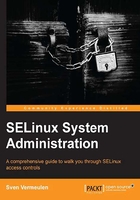
Summary
In this chapter, we saw that SELinux offers a more fine-grained access control mechanism on top of the Linux access control. SELinux uses labels to identify its resources and processes, based on ownership (user), role, type, and even the security sensitivity and categorization of the resource.
Linux distributions implement SELinux policies which might be a bit different from each other based on supporting features such as sensitivity labels, default behavior for unknown permissions, support for confinement levels, or specific constraints put in place, for example, UBAC. However, most of the policy rules themselves are similar.
Switching between SELinux enforcement modes and understanding the log events that SELinux creates when it prohibits a certain access, is the subject of our next chapter. In it, we will also cover how to approach the often-heard requirement of disabling SELinux and why this is the wrong solution to implement.